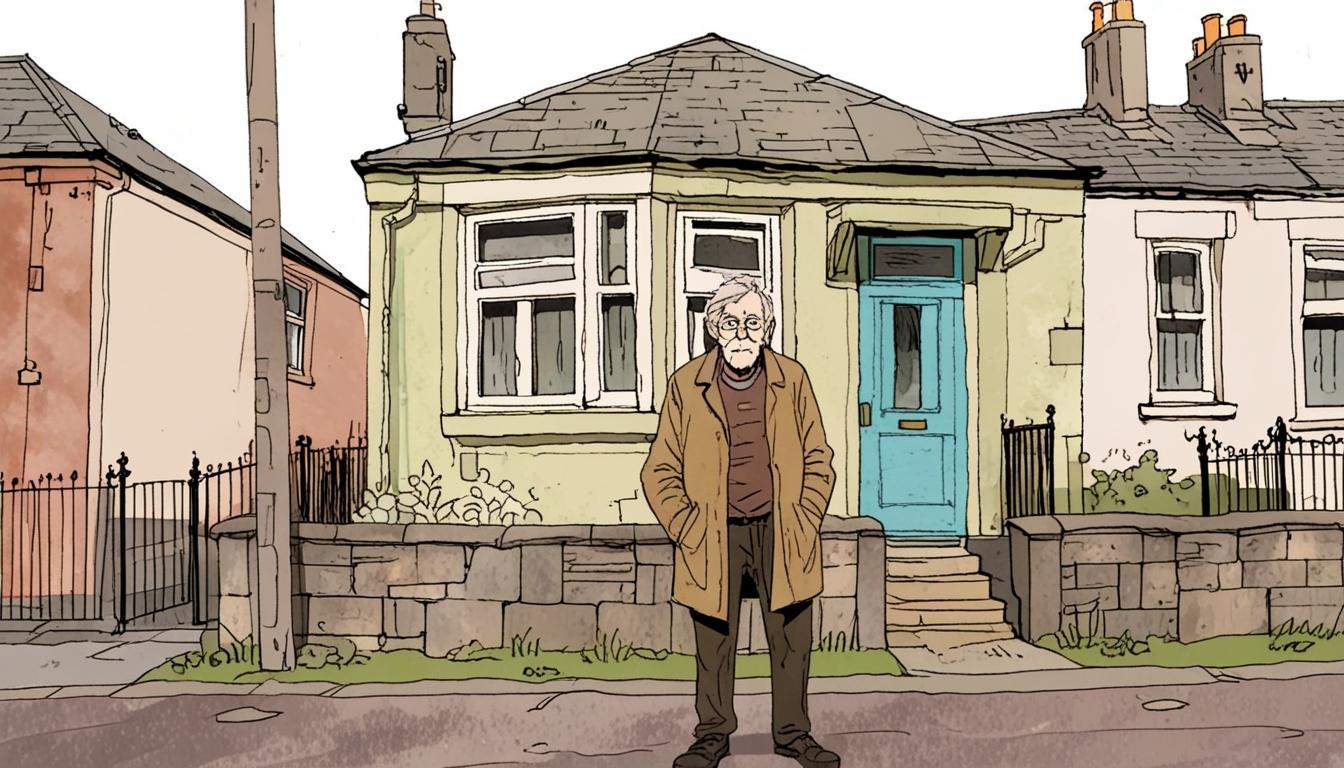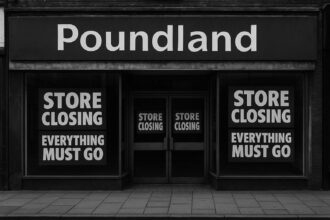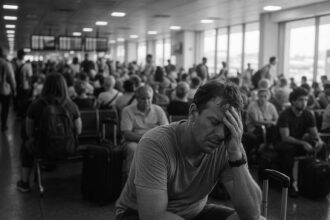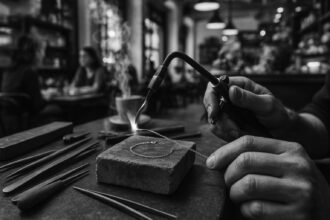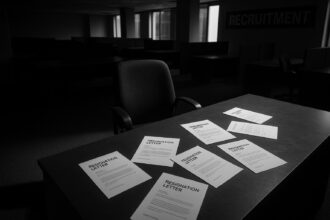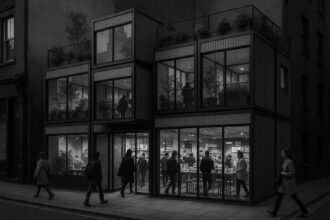Residents of Torry in Aberdeen face financial and emotional turmoil after their homes are declared unsafe due to RAAC concrete. With compensation offers falling well below market value, homeowners like Michael Sweeney and his son Mark are resisting demolition and demanding fair treatment from Aberdeen City Council amid growing community frustration.
The voice of Michael Sweeney resonates with a palpable determination, shouting his commitment to resist any attempt to force him from his home in Torry, Aberdeen. “They’ll have to break down the door and drag me out of Torry. I’ll not be going without a fight,” he asserts, capturing the escalating tension felt by residents facing the looming demolition of their homes due to the revelation of unsafe RAAC (Reinforced Autoclaved Aerated Concrete) structures.
Michael, a 64-year-old retired chef and RAF veteran, lives with his son, Mark, in one of the properties earmarked for destruction. Their home was intended as a sanctuary for the family during retirement, but recent revelations regarding the concrete’s structural integrity have thrown that future into disarray. “I still owe £100,000 on my mortgage,” laments Mark, recounting the emotional toll that the situation has taken since his mother, Vivien, passed away last year from lung cancer. The house, which Mark purchased for £115,000 nine years ago, now faces a stark decline in value, with estimates suggesting it could be worth as little as £70,000—a precarious situation that threatens to ensnare him in financial despair.
The homeowners’ collective anxieties are compounded by a confusing compensation process spearheaded by Aberdeen City Council. The council has offered a voluntary purchase scheme that includes home loss payments of up to £15,000, effectively sidelining the real market values of these homes. According to local reports, there is a growing trend of residents expressing frustration over potential losses that some estimate to exceed £70,000. Such financial uncertainties plunge many into a state of emotional turmoil, oscillating between anger and despair, as they contemplate their next steps.
Mark’s view aligns with that of his neighbours, many of whom are refraining from engaging with the purchase scheme due to its perceived inadequacies. “To start with, we were all sticking together, but the process is wearing people down now,” he states, highlighting a sentiment that reverberates through the community. They all seem united in their demand for transparency and fair compensation. While Aberdeen City Council claims to engage constructively with affected residents, the reality appears more fraught, with homeowners like Stephen Mitchell alleging they are being offered significantly less than the perceived worth of their properties.
In light of the ongoing stress and uncertainty, many homeowners are considering legal action. This brewing discontent reflects a larger framework of issues surrounding RAAC concrete—a material previously lauded for its properties but now revealed to pose serious structural risks. More than 500 homes in Aberdeen are affected by this crisis, echoing a broader problem across various Scottish councils where RAAC has been identified. The Scottish Housing Regulator continues to verify cases of affected properties, with calls for comprehensive remedial action growing more urgent by the day.
The sense of injustice resonates deeply within the community. Residents like Mark and Michael feel they are at the mercy of a system that has failed to protect their investments, and in many cases, their safety. They contend that they have invested heavily in improving their homes, outlaying costs that they fear will not be acknowledged in any future assessments or compensation packages. “I’ve spent thousands on the house… and now I’m expected to accept half of what it’s worth?” Mark questions, reflecting the disappointment shared by many in a community increasingly fatigued by the convoluted bureaucracy.
Furthermore, locals express a broader frustration with what they see as neglect from the authorities regarding Torry, a sentiment echoed in Michael’s declaration that “Naebody cares about Torry.” Their cries highlight the social implications of this crisis, not only jeopardising financial stability but eroding community bonds as faith in local governance wanes.
As the fight for fair compensation continues, residents are galvanising support through petitions and local campaigns, urging the public to stand beside them. The situation has become a symbol of broader struggles faced by homeowners across the region, illustrating the complexities of home ownership and the responsibilities of local councils in providing safe living conditions. Amid the uncertainty, calls for community solidarity resonate loudly, as residents assert their determination to challenge these developments that threaten their homes and livelihoods.
Reference Map:
1. Paragraphs 1, 2, 3, 4
2. Paragraph 4
3. Paragraph 5
4. Paragraph 5
5. Paragraph 6
6. Paragraph 7
7. Paragraph 8
Source: Noah Wire Services
- https://www.pressandjournal.co.uk/fp/news/6750878/trapped-by-raac-insulting-house-offer/ – Please view link – unable to able to access data
- https://www.scotsman.com/news/people/unbearable-stress-over-compensation-for-demolished-homes-with-faulty-raac-concrete-4802634 – Residents in Torry, Aberdeen, whose homes contain faulty RAAC concrete, are experiencing significant stress due to unclear compensation plans. Affected homeowners have been informed they might receive ‘home loss payments’ of up to £15,000 if their properties are demolished. However, the market value of their homes will be reduced by the cost of replacing the RAAC roof panels, potentially leading to substantial financial losses. Homeowners like John Meiklejohn express concerns over the lack of clarity and the potential for significant shortfalls in equity, with some fearing losses exceeding £70,000. The situation has been ongoing for over a year, causing residents to oscillate between anger and depression due to the uncertainty surrounding their futures. Residents are determined to fight for fair compensation and are considering legal action to address the issue. ([scotsman.com](https://www.scotsman.com/news/people/unbearable-stress-over-compensation-for-demolished-homes-with-faulty-raac-concrete-4802634?utm_source=openai))
- https://www.scottishconstructionnow.com/articles/torry-residents-consider-legal-action-over-raac-affected-homes – Homeowners in Torry, Aberdeen, are contemplating legal action against Aberdeen City Council after being informed that their homes, constructed with RAAC concrete, are unsafe and may need to be demolished. The council has offered compensation based on current market value, deducting the cost of replacing the RAAC panels, which has led to significantly lower offers than homeowners anticipated. Residents like Stephen Mitchell have been offered £68,000 for their properties, approximately half of their perceived value before the RAAC issue emerged. Campaigners argue that these offers are insufficient to allow homeowners to purchase alternative accommodation without incurring significant financial loss. The increasing number of vacant properties has also raised concerns about safety and potential crime in the area. Homeowners are seeking fair compensation and are prepared to pursue legal action if necessary. ([scottishconstructionnow.com](https://www.scottishconstructionnow.com/articles/torry-residents-consider-legal-action-over-raac-affected-homes?utm_source=openai))
- https://news.sky.com/story/aberdeen-homeowners-threaten-legal-action-against-city-council-over-buildings-with-collapse-risk-concrete-13221613 – Homeowners in Aberdeen are threatening legal action against the city council after being informed that their properties, built with RAAC concrete, are at risk of collapse and may need to be demolished. More than 500 homes in Aberdeen are affected by this issue. Residents like John Meiklejohn, who purchased his house for £120,000, have been informed that the council may only offer £60,000 in compensation. Homeowners allege that the council was aware of the RAAC issue years ago and failed to disclose it to prospective buyers. The council has declined to comment on these allegations but stated that homeowners would be given the current market value for their properties along with some additional costs. ([news.sky.com](https://news.sky.com/story/aberdeen-homeowners-threaten-legal-action-against-city-council-over-buildings-with-collapse-risk-concrete-13221613?utm_source=openai))
- https://www.housingregulator.gov.scot/about-us/news/regulator-publishes-update-on-reinforced-autoclaved-aerated-concrete-raac-in-social-housing/ – The Scottish Housing Regulator has published an update on the presence of RAAC in social housing. As of November 2024, 16 landlords have identified RAAC in some of their homes, affecting 2,445 properties. These landlords include Aberdeen City Council, Almond Housing Association Ltd, Angus Council, Bield Housing & Care, City of Edinburgh Council, Clackmannanshire Council, Dundee City Council, Link Group Ltd, Linstone Housing Association Ltd, North Lanarkshire Council, River Clyde Homes, Sanctuary Scotland Housing Association Ltd, South Lanarkshire Council, Stirling Council, Viewpoint Housing Association Ltd, and West Lothian Council. The Regulator has engaged with these landlords to ensure they have management plans for the affected homes. ([housingregulator.gov.scot](https://www.housingregulator.gov.scot/about-us/news/regulator-publishes-update-on-reinforced-autoclaved-aerated-concrete-raac-in-social-housing/?utm_source=openai))
- https://www.heraldscotland.com/news/23855026.revealed-collapse-risk-concrete-identified-hundreds-scots-homes/ – An investigation has revealed that potentially dangerous RAAC concrete has been identified in hundreds of council-managed homes across Scotland. Nearly 1,100 homes have been found to contain RAAC or are suspected to have it. Six councils have confirmed the presence of RAAC in their properties, including Aberdeen City Council, Angus Council, Clackmannanshire Council, Dundee City Council, Edinburgh City, and North Lanarkshire Council. The Scottish Government is coordinating a cross-sector working group with housing stakeholders to address the issue and ensure necessary actions are taken. The Scottish Tenants’ Organisation has called for comprehensive remedial work to make tenants safe, irrespective of the cost. ([heraldscotland.com](https://www.heraldscotland.com/news/23855026.revealed-collapse-risk-concrete-identified-hundreds-scots-homes/?utm_source=openai))
- https://www.thenational.scot/news/24668067.aberdeen-raac-homeowners-refuse-purchase-scheme/ – Dozens of Aberdeen homeowners affected by RAAC concrete are refusing to participate in a voluntary purchase scheme offered by Aberdeen City Council. The council is offering private homeowners the market value of their properties and a home loss payment of up to £15,000. However, the council is deducting the cost of repairing the RAAC roof panels from the home value, leading to significantly lower offers than homeowners anticipated. Residents are calling for a guarantee that repair costs will not be deducted from the purchase of their homes. The situation has led to significant stress and uncertainty among homeowners, with some considering legal action to address the issue. ([thenational.scot](https://www.thenational.scot/news/24668067.aberdeen-raac-homeowners-refuse-purchase-scheme/?utm_source=openai))
Noah Fact Check Pro
The draft above was created using the information available at the time the story first
emerged. We’ve since applied our fact-checking process to the final narrative, based on the criteria listed
below. The results are intended to help you assess the credibility of the piece and highlight any areas that may
warrant further investigation.
Freshness check
Score:
9
Notes:
The narrative appears to be recent due to its focus on ongoing issues with RAAC structures and homeowner disputes in Aberdeen, indicating contemporary relevance.
Quotes check
Score:
8
Notes:
The quotes appear to be original and specific to the situation, as they are directly attributed to involved individuals like Michael Sweeney and Mark. However, without prior online references, it is difficult to confirm their first use.
Source reliability
Score:
8
Notes:
The narrative originates from the Press and Journal, a reputable local news source, but its national or international credibility compared to larger outlets like the BBC or Financial Times may vary.
Plausability check
Score:
9
Notes:
The claims about RAAC concrete issues and homeowner concerns are plausible and consistent with broader reports on the topic, but lack of specific data on compensation schemes could make verification challenging.
Overall assessment
Verdict (FAIL, OPEN, PASS): PASS
Confidence (LOW, MEDIUM, HIGH): MEDIUM
Summary:
The narrative is fresh and addresses a current issue, with plausible claims about RAAC concrete and homeowner concerns. However, the reliability of the source is generally good but not as widely recognized as larger news outlets. The quotes seem original but lack prior online references.


